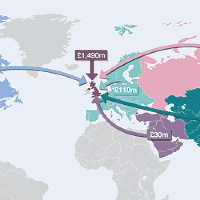A Vital Export
International student numbers may rise after the General Election
Assuming students are excluded from immigration targets in party manifestos, we forecast international student numbers to rise by 6% per year over the next three years.
This reflects the growth in the number of students worldwide who study overseas (OECD). In reality, growth may be much higher than this as access to UK higher education has been restricted to overseas students for so long.
■ Show me the money: The UK attracted 112,000 fulltime students from the EU and 285,000 from other countries last year, making up just under 23% of the full-time student population. These students contribute £25bn (Universities UK) to the UK economy each year through tuition fees and other spending such as accommodation and services.
They are also a key asset contributing to the UK’s “soft power” – our ability to influence and negotiate with other nations. According to research from the British Council, one in seven world leaders has studied in the UK. With Brexit brokering and trade talks on the horizon, international relations more important than ever. Maintaining these links will be absolutely vital.
■ Chinese satellites: University applications from Chinese students have almost doubled over the last decade, to 14,000 in 2016. With the sterling – yuan exchange rate 8% lower than it was before the EU referendum, we can expect this demand growth to continue.
Peking University’s satellite campus in Oxford marks an exciting step forward for education links between the two countries, further to increased student numbers. Peking is ranked 27th in the world on the Times Higher Education University Guide, making it highly competitive with many UK institutions. It will allow students to spend their first year in Oxford, before continuing the rest of their course in Shenzhen, China.
■ Manifesto madness: Any hope for a quiet, politics-free summer was smashed last month with the announcement of a June General Election. There are many reasons we should be accepting – welcoming – international students into the UK. With students cut from government immigration targets, UK universities could open their arms to overseas markets and drive growth in international student numbers.
Politicians of all parties must recognise that international students make an enormous cultural and economic contribution to the UK – to the tune of tens of billions of pounds each year. This election presents them with the chance to reflect this in their manifestos.
.png)
.png)
.png)
.jpg)





.png)